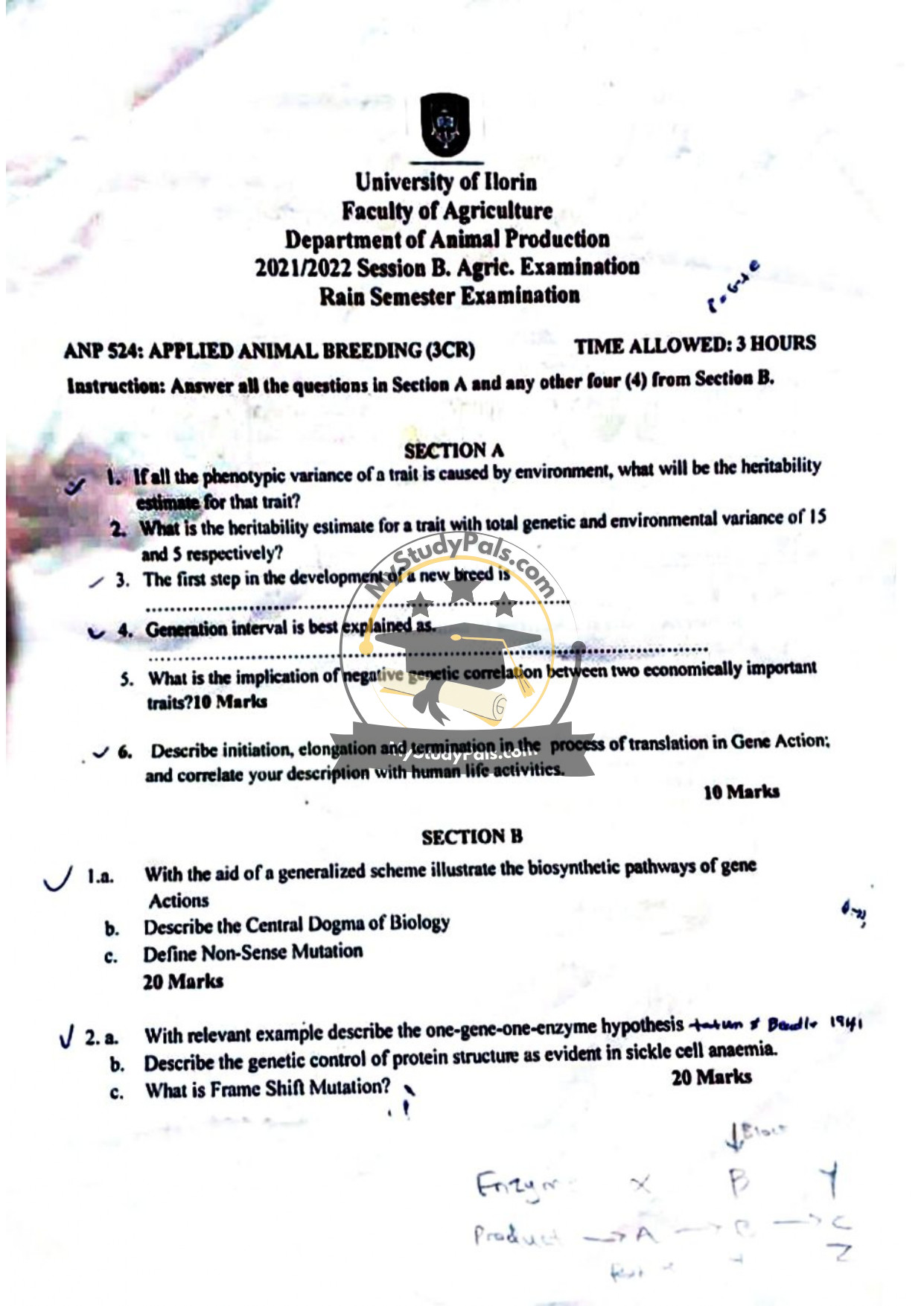ANWSER
Question 1:
Define the term repeatability as used in genetics and breeding.
Answer:
Repeatability is a measure of the consistency of an animal’s performance for a trait across multiple records or time periods. It estimates the proportion of total phenotypic variance that is due to permanent environmental and genetic effects, excluding temporary environmental effects.
—
Question 2:
State the primary three (3) uses of repeatability estimates in animal breeding.
Answer:
1. Predicting future performance: Helps breeders estimate an animal’s future performance based on its past records.
2. Culling decisions: Assists in identifying animals with consistently poor or superior performance for selection or culling.
3. Determining recording intervals: Guides the number of records needed to reliably evaluate an animal’s genetic merit.
—
Question 3:
Calculate the repeatability estimate for litter size among the sows using the provided data.
Answer:
To calculate repeatability, we use the formula:
\[
\text{Repeatability} (r) = \frac{\sigma^2_{\text{between sows}}}{\sigma^2_{\text{between sows}} + \sigma^2_{\text{within sows}}}
\]
Step-by-Step Calculation:
1. Calculate the mean litter size for each sow:
– Sow 1: (8 + 10 + 12 + 10)/4 = 10
– Sow 2: (5 + 8 + 10 + 12)/4 = 8.75
– Sow 3: (8 + 8 + 10 + 12)/4 = 9.5
– Sow 4: (10 + 12 + 11 + 12)/4 = 11.25
– Sow 5: (9 + 12 + 12 + 13)/4 = 11.5
– Sow 6: (9 + 10 + 11 + 12)/4 = 10.5
2. Overall mean (\(\mu\)):
\[
\mu = \frac{10 + 8.75 + 9.5 + 11.25 + 11.5 + 10.5}{6} = 10.25
\]
3. Variance between sows (\(\sigma^2_{\text{between}}\)):
\[
\sigma^2_{\text{between}} = \frac{\sum (\text{Sow mean} – \mu)^2}{n_{\text{sows}}} = \frac{(10-10.25)^2 + (8.75-10.25)^2 + \dots + (10.5-10.25)^2}{6} = 0.9375
\]
4. Variance within sows (\(\sigma^2_{\text{within}}\)):
Calculate the variance for each sow’s litter sizes, then average:
– Sow 1: Variance = 2
– Sow 2: Variance = 8.1875
– Sow 3: Variance = 3
– Sow 4: Variance = 0.6875
– Sow 5: Variance = 2.25
– Sow 6: Variance = 1.25
\[
\sigma^2_{\text{within}} = \frac{2 + 8.1875 + 3 + 0.6875 + 2.25 + 1.25}{6} \approx 2.8958
\]
5. Repeatability estimate:
\[
r = \frac{0.9375}{0.9375 + 2.8958} \approx 0.245 \text{ (or 24.5%)}
\]
Final Answer: The repeatability estimate for litter size among the sows is approximately 0.245 (24.5%).
—
Question 4:
Define Mutation; state its effect on genes and phenotypes.
Answer:
Mutation is a permanent alteration in the DNA sequence of a gene.
Effects:
– Genes: Changes the genetic code, potentially altering protein function.
– Phenotypes: May lead to new traits, disorders, or no observable change (silent mutation).
—
Question 5:
Differentiate transcription and translation effects of genes.
Answer:
– Transcription: Process where DNA is copied into mRNA in the nucleus.
– Translation: Process where mRNA is decoded by ribosomes to synthesize proteins in the cytoplasm.
—
Question 6:
Describe the following types of mutations:
1. Missense Mutation: A nucleotide change that results in a different amino acid in the protein.
2. Repeat Expansion: Increase in the number of repeated DNA sequences, often causing diseases.
3. Deletion: Removal of one or more nucleotides, potentially disrupting the gene.
4. Insertion: Addition of nucleotides, which may shift the reading frame.
5. Lethal Mutation: A mutation that results in non-viability or death of the organism.
—
Question 7:
Define gene and state its functions.
Answer:
A gene is a segment of DNA that encodes a functional product (e.g., protein or RNA).
Functions:
– Determines traits through protein synthesis.
– Regulates biological processes.
– Passes genetic information to offspring.
—
Question 8:
Complete the table for types of gene interactions and their ratios.
Answer:
| S/N | Types of Gene Interaction | Ratio |
|—–|—————————|———————|
| 1 | Typical Di-hybrid | 9:3:3:1 |
| 2 | Complementary Factor | 9:7 |
| 3 | Supplementary Factor | 9:3:4 |
| 4 | Polymerism | 15:1 |
| 5 | Epistatic Factor | 12:3:1 or 9:3:4 |
| 6 | Inhibitory Factor | 13:3 |
| 7 | Additive Factor | 9:6:1 |
—
Question 9:
Explain substitution and its effects on amino acid codons.
Answer:
– Substitution: Replacement of one nucleotide with another in a DNA sequence.
– Effects:
– Silent Mutation: No change in amino acid (due to codon redundancy).
– Missense Mutation: Alters the amino acid, potentially affecting protein function.
– Nonsense Mutation: Creates a stop codon, truncating the protein.
—
Question 10:
Explain narrow-sense heritability and methods to estimate it.
Answer:
– Narrow-sense heritability (\(h^2\)): Proportion of phenotypic variance due to additive genetic effects.
– Estimation Methods:
1. Parent-offspring regression.
2. Half-sib analysis.
3. Response to selection.
—
Question 11:
Differentiate full-sib and half-sib in a breeding experiment.
Answer:
– Full-sib: Offspring sharing both parents.
– Half-sib: Offspring sharing only one parent (e.g., same sire, different dams).
—
Question 12:
Complete the ANOVA table and calculate heritability components.
Answer:
Completed ANOVA Table:
| Source of Variation | DF | Sum of Square | Mean Square | Estimated Mean Square |
|———————|—–|—————|————-|———————–|
| Sire | 4 | 120 | 30 | \(\sigma^2_w + 4\sigma^2_d + 20\sigma^2_s\) |
| Dam | 25 | 400 | 16 | \(\sigma^2_w + 4\sigma^2_d\) |
| Within Dam | 90 | 900 | 10 | \(\sigma^2_w\) |
Calculations:
1. Heritability due to sire (\(h^2_s\)):
\[
h^2_s = \frac{4\sigma^2_s}{\sigma^2_s + \sigma^2_d + \sigma^2_w} = \frac{4 \times 1}{1 + 1.5 + 10} \approx 0.32
\]
2. Heritability due to dam (\(h^2_d\)):
\[
h^2_d = \frac{4\sigma^2_d}{\sigma^2_s + \sigma^2_d + \sigma^2_w} = \frac{4 \times 1.5}{1 + 1.5 + 10} \approx 0.48
\]
3. Combined heritability:
\[
h^2_{\text{combined}} = \frac{\sigma^2_s + \sigma^2_d}{\sigma^2_s + \sigma^2_d + \sigma^2_w} = \frac{1 + 1.5}{1 + 1.5 + 10} \approx 0.20
\]
Final Answers:
– \(h^2_s \approx 0.32\)
– \(h^2_d \approx 0.48\)
– \(h^2_{\text{combined}} \approx 0.20\)
—




